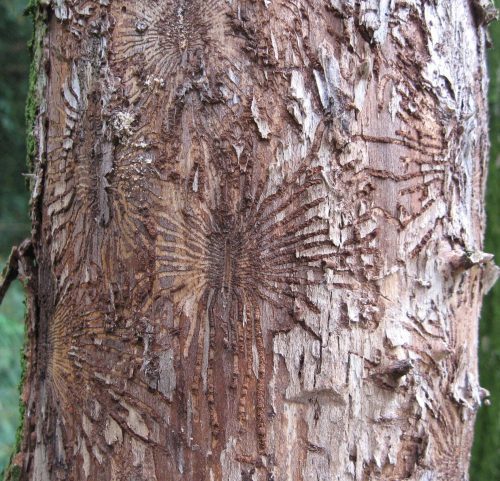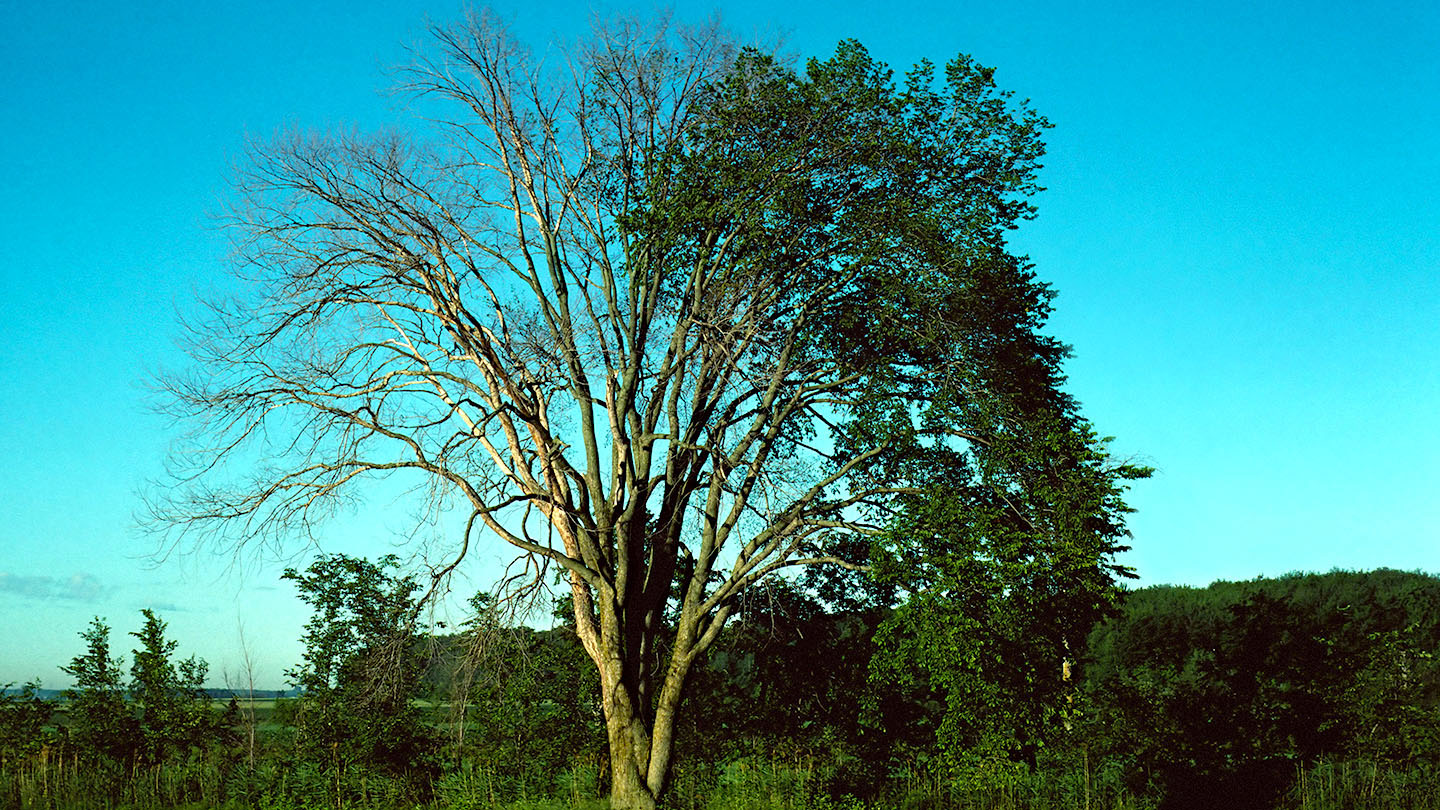Dutch elm disease (DED) was first brought to North America during the Second World War when infected elm lumber was imported from Europe and has been slowly making its way towards Alberta ever since. Fortunately, there have been only a few isolated cases in the province, with one being in Wainwright in 1998 and, more recently, in Lethbridge in 2020. Aside from these cases, Dutch elm disease is not common in Alberta, despite there being carriers in the province since the 1990’s. Dutch elm disease kills American and Siberian elm trees within months of infection and spreads rapidly. Arborists and government officials in Alberta are aware of the impact this disease could have on the province, and it is because of this diligence that Alberta has one of the last healthy elm populations in the world. This article will discuss the ways in which we can continue to protect our elm trees by helping you understand the issue and the steps we take to prevent DED in Alberta.

The Problem
Dutch elm disease is a lethal attack on elm trees perpetrated by two nasty villains: Elm Bark Beetles and fungus. There are three varieties of the Elm Bark Beetle: Native Bark Beetle, Smaller European Elm Bark Beetle, and the Banded Elm Bark Beetle. All three can carry DED and attack elm trees in similar ways. In the spring they search for dying elm trees or elm deadwood to bore into. These trees become brood trees where the beetles will build galleys and lay their eggs. After the eggs hatch, the larvae will feed on the inner bark layers of the tree until emerging as adults. This process will be repeated two to three times a season, depending on the weather conditions. The adults will briefly feed on healthy elm wood before searching for a new host, which is how the disease can spread so quickly.
While the bark beetles carry the disease and help accelerate its spread, the actual damage is caused by the funguses Ophiosoma Ulmi and O.Novo-Ulmi. These fungi are extremely aggressive and reproduce both asexually and sexually. They will use the beetles, the beetle’s galleys, and the trees’ natural distribution system to spread through the tree, killing it systematically. This process can take only a few months with aggressive infections or longer when conditions are not favorable for the beetle and fungus.
Once a tree is infected with Dutch elm it attracts even more bark beetles causing the disease to spread more rapidly, making it more difficult to be dealt with. Therefore, immediate removal of infected trees is a priority.
The Victims
Elm trees are the only victims of DED. Elm trees can be identified by their vase shaped growth pattern with one sturdy trunk leading into a widespread upward growing canopy. The leaves are oblong and serrated towards the tip with distinctive veins leading from the leaf center to the leaf edge. The serration is uneven with one side of the leaf being slightly longer than the other. Healthy elm leaves are rich green on top and a paler green underneath. Mature elm bark is very rough and ranges from brown to grey. Sometimes elm bark in Edmonton can be charry black, due to a sooty mold that grows from elm scale excrement.
Elm bark beetles usually target mature trees that are large enough to be long-term hosts, specifically two-crotch trees and anything larger. Two crotch trees have a major crotch on stems leading from the first crotch on the trunk.
American elms have a neat and tidy structure that grows up then out. It is a fast growing and large tree reaching up to 100ft in maturity and spreading up to 50ft. American elms are popular in urban settings due to their toughness and habit to grow up and out of the way.
Siberian Elm trees are smaller than Americans and grow in a messy, uneven pattern with smaller leaves. Mature Siberian elm can get up to 70ft tall and 30ft wide. Despite being tough and having a higher resistance to DED, the Siberian elm does not have as long of a life span.
There are other types of elm trees in Alberta, such as the Chinese elm, Brandon elm and Little Leaf, along with many other hybrids and cultivars. Although these varieties are not as common in Alberta, many have been bred to be resistant to DED. Even if some varieties are resistant there is no species found that is completely immune.
The Symptoms
The symptoms of DED are very easy to identify while the symptoms of Bark beetle infestation are less so.
Bark beetle infestations can be hard to spot early on, as the beetle is very tiny. Their entry hole is about the size of the tip of a ball point pen but, with careful examination, it can be identified. Look for frass or sawdust around the hole and on the ground. Trees with a larger infestation will have more frass at the tree base. It is also common to see holes created by sap sucker birds in elm bark. However, these will be larger than the tip of a ball point pen and will have many holes beside one other in neat rows. Sap suckers will not kill a healthy tree unless it is already dying. If you have a damaged elm tree or are removing one, then you may see evidence of the bark beetle under the bark where obvious galleys may be seen where a bark beetle bored in and laid eggs.
DED symptoms are easier to spot. The first sign is the leaves on a branch or multiple branches will suddenly wilt and turn yellow. This usually occurs at the end of June/ end of July. These leaves will turn brown over the summer and the entire trees’ canopy may turn yellow and fall off earlier in the fall than normal. DED symptoms will be concurrent with those of the bark beetles infestation.

What can be done
The way to keep DED out of Alberta and under control lies in prevention. Preventing DED means following bylaws regarding elm trees and keeping your trees as healthy as possible, since bark beetles are attracted to dead and dying elm trees.
- Monitor your elm trees closely and if symptoms of DED appear, the city asks that you report it by calling 311. If the trees are city owned, you can email citytrees@edmonton.ca. If the tree is privately owned, you can email treebugs@edmonton.ca. You can also contact any certified arborist to correctly identify and deal with any infected trees.
- Follow city bylaws and only prune elms between October 1st and March 31st. Bark beetles are active between April 1st and September 30th and are attracted to the scent released from fresh cuts.
- Do not store or transport elm firewood. Elm wood can be disposed of at designated city drop-offs or by certified arborists.
- Elm trees can be removed at any time. If an elm tree is removed, the stump needs to be ground 10 cm inches below ground level or the bark must be debarked.
- Keep your trees healthy, deadwood can attract bark beetles and weaken the tree. During elm pruning season, remove deadwood or any structural issues that may become deadwood or break.
- Ensure that your tree is getting enough water. Elm trees should be watered during drought and in the fall before the first frost. Watering in the fall will help the tree during our harsh winters. Do not over water and be sure to water around the drip line and not on the trunk.
- Fertilize your elm tree. Fertilizing should be done with the correct fertilizer in the correct amount, depending on your tree.
- Check on newly planted elm trees to ensure their stakes and wiring are not causing damage.
- Monitor your trees’ general health and have parasites treated as they are discovered. Common elm parasites are elm scale, thrips, aphids, and leaf rollers. These insects are usually more of an annoyance than anything unless they become heavily infested.
- Another disease that targets elm trees is Dothiorella. This disease has similar symptoms to DED but does not always have sbark beetle activity. A DED infested tree will have noticeable amounts of bark beetle activity.
What Kentucky Blue Grass can do for you
Our certified arborists can identify issues, prune out the problems, maintain health with deep root fertilizing and watering, and treat common elm parasites like elm scale, aphids, leaf roller, and thrips. We can also remove any elm trees that are damaged, dead or at risk.


